PARADISE VALLEY, Ariz. — Subaru owners are a loyal bunch, but as more drivers decide to go greener by driving an electric vehicle, those loyalists have been left behind. The closest thing has been the Crosstrek Hybrid, a plug-in hybrid with a meager 17 miles of electric range. Now, though, there’s the new 2023 Subaru Solterra, the brand’s first all-electric vehicle. However, it was developed in partnership with Toyota and without a Subaru-trademark boxer engine, is it really Subaru enough to keep those loyalists loyal?
The company has told you time and time again that love is “what makes a Subaru a Subaru.” We’d argue there’s more to the recipe than just that (and a boxer engine), as we’ve come to expect certain things from vehicles bearing the stars of Pleiades on their nose. They also need to support an active lifestyle, whether that’s an enthusiast hitting the track in a WRX, or the whole family hitting the trail in the new Outback Wilderness. Of course, in all but the BRZ, we expect standard all-wheel drive to help get to a campsite or make it to work on a snowy day. Subaru even makes sure its crossovers’ roof rails are more capable than most for supporting roof-mounted tents. Also, it’s gotta be good for dogs. Subaru loves dogs.
The Solterra, which appropriately combines the Latin words for sun and Earth, promises all this and more. Besides the missing boxer engine, there’s no continuously variable transmission sending power onto all four wheels. Instead, the Solterra is motivated by a pair of 80-kilowatt electric motors providing the familiar all-wheel drive that helps define Subaru as a brand. Those e-motors are good for a total of 215 horsepower and 249 pound-feet of torque, and its 0-60 time of 6.5 seconds feels like a suitable answer to those who lament the absence of a turbocharged flat-four in something like the Forester.
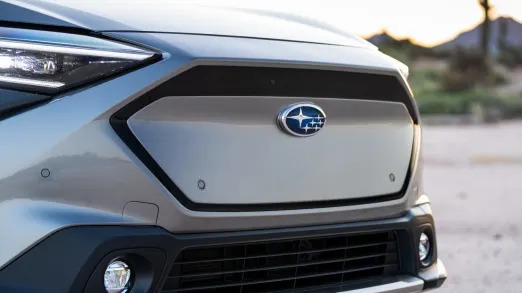
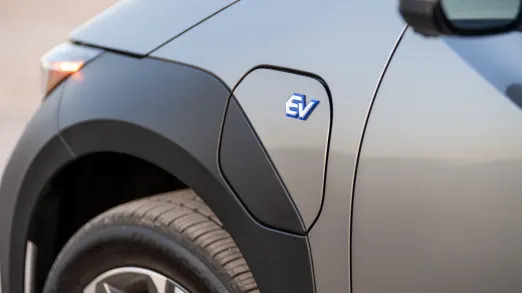
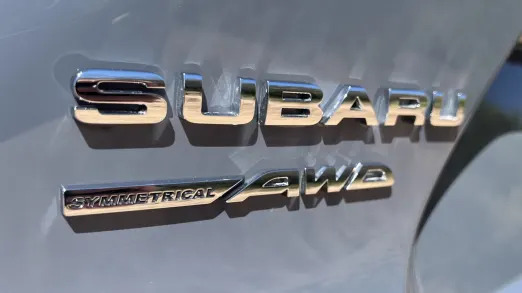

Its 72.8-kilowatt-hour battery provides over 220 miles of driving between charging sessions (228 for the base Premium trim, and 222 for Touring and Limited), which, while not anything close to segment-leading, is plenty for the vast majority of use cases. With a 355-volt battery architecture, the Solterra can take advantage of a 100-kW DC fast charger, recovering 80% of a charge in about 56 minutes. Again, that’s acceptable, but greatly outdone by the 800-volt architecture of the faster-charging Hyundai Ioniq 5 and Kia EV6 that can take advantage of 150- and 350-kW fast chargers. A recharge of the Solterra takes nine hours using a 240-volt Level 2 charger (what you can have installed at home), meaning you can start each day with a full battery.
Are you worried the Solterra won’t be quite as capable as your trusty Outback? Fear not, for the Solterra boasts 8.3 inches of clearance, just a fraction of an inch shy of the excellent 8.7 inches found in Subaru’s other crossovers (minus the new Wilderness models that boast even more). With its relatively short front and rear overhangs, the Solterra has an approach angle of 17.7 degrees, a departure angle of 25.4 degrees and an 18.2-degree breakover angle — not in the realm of purpose-built off-roaders, but enough to allow you to explore many of those forestry roads with confidence. Furthermore, the Solterra has a wading depth of 19.7 inches, which is actually better than the Jeep Cherokee Trailhawk’s safe fording capability (which is 19 inches according to the 2022 model's owner's manual).
The ability to clear rocks and ruts is all well and good, but what about the rest of the whole soft- and off-road experience? The Solterra features an electrified version of Subaru’s dual-function X-Mode drive system with a setting for Snow/Dirt and for Deep Snow/Mud. There’s also the Grip Control feature, which is essentially a crawl mode for maintaining an adjustable low speed, especially during steep hill ascent and descent. This all works as well as you’d hope it would, allowing us to traverse loose gravel roads with speed and grace, while the stability control works nearly imperceptibly to keep the Solterra’s nose pointed where we wanted it (the only clue the car was doing behind-the-scenes work was the stability control icon lighting up on the display). It was happy to crawl over rocks and furrows, and up and down steep dirt hills. The Subaru felt right at home on Tonto National Forest trails we wouldn’t dare tackle in a Hyundai Ioniq 5, Kia EV6, VW ID.4 or Ford Mustang Mach-E.

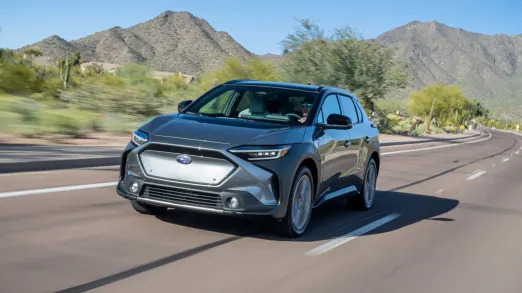
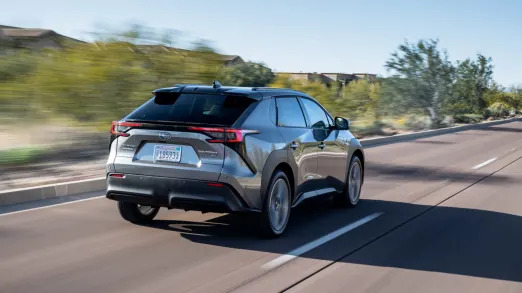
For on-road driving, the Solterra has Normal, Eco and Sport modes to allow you to trade speed for efficiency, or vice versa. The differences between these modes aren’t as dramatic as they can be in other vehicles, but you definitely notice a difference when you put the Solterra into Sport and step on the accelerator. Either way, it pulls smoothly and quickly to highway speeds. There are also four levels of regenerative braking, selectable via paddles mounted on the back of the steering wheel. For the most regen force, there’s a button to turn on S-Pedal mode. Sorry one-pedal drivers, you’ll still have to use the brake pedal to bring the Solterra to a complete stop, no matter what you do.
One piece of the driving experience that doesn’t feel typically Subaru is the ride. The Solterra is exceptionally smooth and quiet, giving it a level of comfort beyond what we’d normally expect. It glides down the road, and handles dips and heaves with a stoic calm, even riding on the 20-inch wheels of the Limited and Touring trims. The four-wheel independent suspension features MacPherson struts up front and double wishbones in the rear, which rebound softly over imperfections taken at speed. Additionally, despite the vehicle’s tallness, body roll is well controlled. After all, its center of gravity is about 3.5 inches lower than that of the standard Forester. In addition to reducing motion in the cabin, the Solterra does a fine job of limiting noise. Of course, there’s no boxer engine chugging away under the hood, but we were also blissfully unaware of tire roar and wind noise.
The Solterra’s cargo area is of a competitive volume. It has an adjustable load floor that, in its higher position, is level with the base of the liftgate. At this height, the Solterra claims 27.7 cubic feet of cargo space, which is half a cube larger than that of the Hyundai Ioniq 5. With the floor in its lower position, the Solterra offers 30.3 cubic feet, which is closer to the Forester’s 31.1 (without the sunroof) and the Outback’s 32.5 cubes. Unlike those siblings, however, the steeper raking of the rear window means that the rearmost height of that cargo area is limited. It might do well in one of Autoblog’s luggage tests, but it seems likely to struggle with bigger, bulkier loads a Forester would swallow with ease.
That might include bigger, bulkier dogs, but at least the rear bumper’s unpainted plastic extends all the way up to the opening of the cargo space to help prevent a dog from scratching the paint has they hop inside. Subaru loves dogs, and so do we.
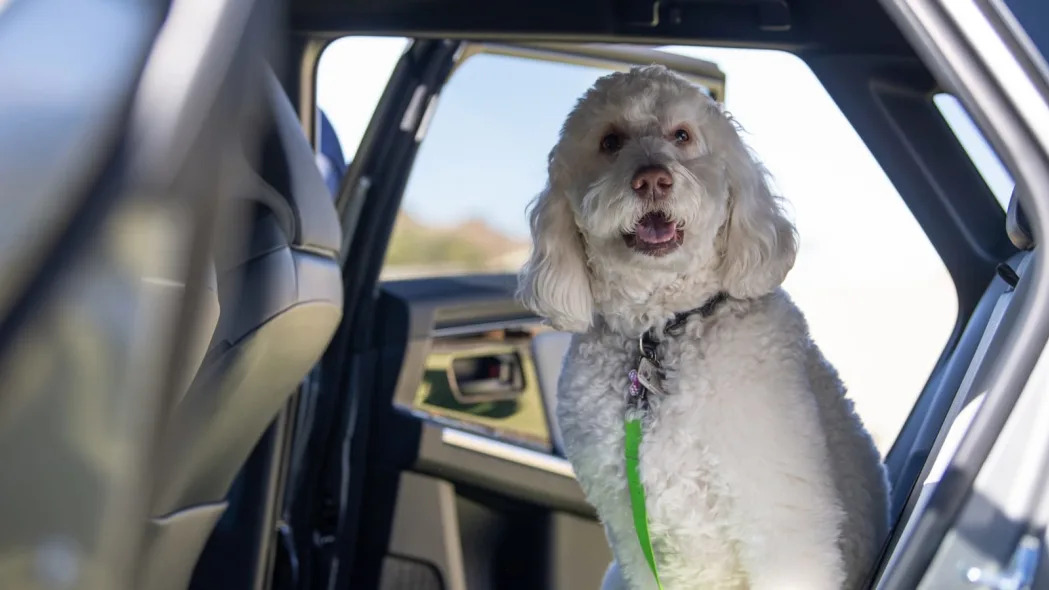
Need to exceed that volume? Solterra’s flush-mounted roof rails may not be the more functional raised variety found on other Subarus, but they are still rated to support up to 700 pounds, or the same as the standard Forester's and considerably more than other brands provide (the Ioniq 5 and EV6 don’t have roof rails at all). In addition to being able to mount a box or rack up there, that also means you can mount a rooftop tent. While the Solterra isn’t rated to tow, there is still an available “activity mount” that can be used for a bike rack or low-capacity cargo boxes. So while you can reserve the roof space for your nightly accommodations, you’ll still be able to surpass the standard cargo capacity.
Oh, and there’s no frunk under the hood. Instead, Subaru smartly packaged things like the front motor, crash structure, and cooling tech for the battery and HVAC systems in that space. In addition to reducing that front overhang, the result is a crossover with excellent legroom in both seating rows. Having that extra legroom is crucial, as the Solterra’s floor feels high, and the roof feels low. The front occupants are hemmed in in what feel like individual pods by the doors and center console. The lack of a transmission, though, means that there is storage space beneath that center console as well.
The mounting of the digital gauge cluster is a bit odd, but the low dash and cowl mean excellent forward visibility (another expected Subaru trait). The instrument cluster is mounted far forward, surprisingly close to the windshield. The gives an effect similar to a head-up display, as you have to adjust your focal point less when your eyes move from the road ahead to the gauges on the dash. That distance means some of the smaller information, like the digits on your trip meter, can be hard to read. It also means that, depending on your seating position, your view of the instruments might be partially obscured by the steering wheel. We found we had to strike a balance between a comfortable wheel position and our ability to see that digital screen, which we were able to do after some fidgeting.
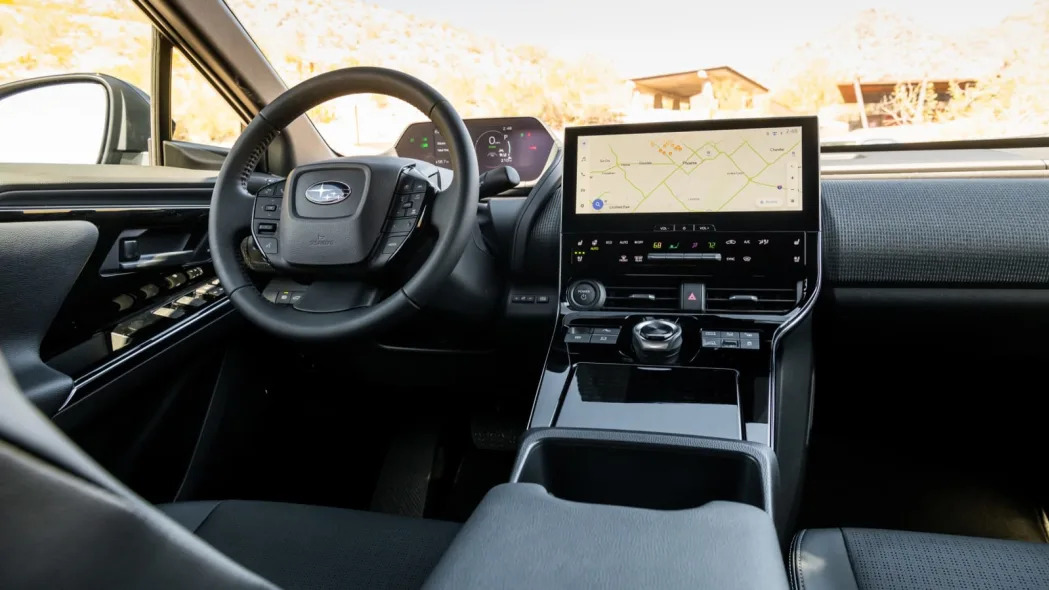
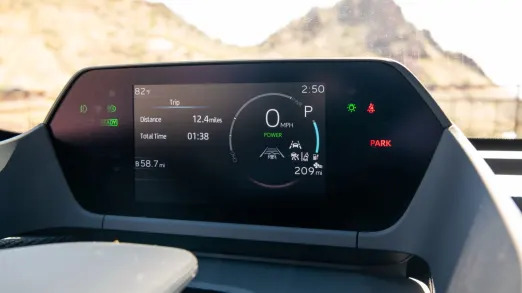

The base Solterra Premium comes standard with an 8-inch infotainment system, and the Limited and Touring models are equipped with a bright, crisp 12.3-inch unit with cloud-based navigation. Both are effectively Toyota infotainment systems reskinned for Subaru. The larger screen is also home to the 360-degree parking camera feed (a first for Subaru) that’s also standard on the two higher trims. They also feature a virtual assistant, so you can give the Solterra voice commands, waking it with the phrase, “Hey, Subaru.” It works well, but be careful, as the car can be told what to do by passengers in the second row as well (like we need our backseat drivers having that power). Regardless of the trim level, every Solterra comes with wireless Apple CarPlay and Android Auto as standard. Limited and Touring models also have a wireless phone charger on the center console.
The Solterra also advertises Subaru’s EyeSight driver assistance system, but it’s almost certainly Toyota’s latest driver assistance systems renamed for Subaru use. This isn’t a bad thing. It still employs a camera and radar, while providing a lineup of features that includes adaptive cruise control, lane-keeping assist, emergency forward braking, emergency steering assist, pedestrian and cyclist avoidance, lead vehicle start alert and road sign recognition. The Solterra also features blind spot monitoring, auto reverse braking with pedestrian detection, as well as a “Safe Exit Assist” that warns you if you’re opening your door into traffic. In all, we found that the Solterra beeped and nagged us less than our seemingly anxious long-term Forester, and also performed the driving assistance more adeptly and seamlessly.
There are still some things we don’t yet know about the Solterra, the biggest being pricing. Subaru told us we can expect “ballpark competitive” pricing with other electric crossovers. That includes, presumably, the Solterra’s Toyota bZ4X twin that we’ll be driving in two weeks. If the base MSRP can do the limbo under $40,000, we won’t be surprised. The Solterra will also be eligible for the full $7,500 federal EV tax credit, along with any other local incentives. We also don’t know what sort of charging freebies customers can expect. Subaru is partnering with EVgo, and will offer some sort of incentive through that charging network, but those details haven’t been disclosed as of yet.
What we do know is that this electric Solterra does, indeed, feel like a Subaru. Customers who have been patiently waiting for an EV from their brand will finally get their chance around the middle of the year. Thankfully, the Solterra lives up to expectations, providing most of the capabilities of the trusty Foresters and Outbacks it will replace in loyal customers’ driveways and garages. It will just do it a lot more cleanly and quietly.
Related Video:


















Sign in to post
Please sign in to leave a comment.
Continue